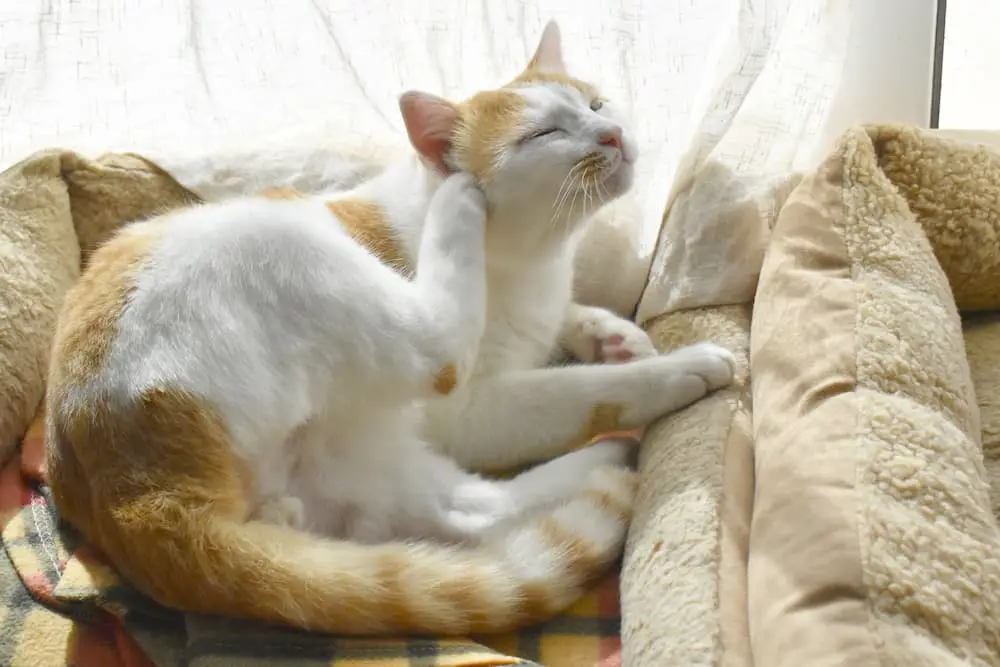Flea collars are still very popular among pet owners. Years ago, they used to be the most popular and affordable method against fleas infestation on cats. However, nowadays there are far safer and more effective ways to battle the pests.
Anyway, some cat owners still prefer buying collars as they are affordable and easy to use. But do you actually know how the cat flea collars work and are they beneficial at all?
We asked flea control specialist Jordan Foster to get qualified answers to these and more questions regarding the truth behind cat flea collars.
So, How Do Cat Flea Collars Work?
Flea collars are soaked with special ingredients. When applied, the collar has the ability to emit a gas that should exterminate or repel the fleas. Other collars release chemicals that reach the whole body of the cat, not only around the neck and head.
Basically, the first type of collar works as a repellent as it has a very small scope. Moreover, the fleas should bite the cat and only then they will be eradicated by the ingredients. The other flea collar has a treating function as it can reach each part of the body and fleas can be killed before the bite, as well. There are cat flea collars that have both repelling and treating functions.
Related: 10 Freaky Facts You Didn’t Know About Fleas & Ticks
How Long Does it Take for a Flea Collar to Work?
It depends on the type of flea collar. The chemical products which are more powerful should work within 24 hours after you apply the collar. On the other hand, flea collars with more natural ingredients might take longer to work and usually, it happens within 4 weeks.
Advantages of a Cat Flea Collar
So, flea collars for cats have their advantages and we will point few of them:
- Appropriate when dealing with fleas around the neck and head where they mostly compile.
- They are convenient. Usually, cat flea collars can be found over-the-counter, they don’t require any additional applications. Pet owners just need to buy it and put it on the cat’s neck.
- Flea collars are usually a cheap solution and that’s why they are still popular.
- They protect much longer. Other treatments and medications usually work for no more than 30 days which means they should be applied regularly. For example, some specially designed cat flea collars can work for up to 8 months.
Disadvantages of a Cat Flea Collar
Of course, there are many disadvantages to using cat flea collars as a treatment method:
- Flea collars are not as effective as regular vet visits as they usually cannot protect the entire body and others are not that powerful to kill fleas at all.
- They can pose harm to humans: according to a study by the National Resources Defense Council, there are cat flea collars that contain the pesticides tetrachlorvinphos and propoxur which are hazardous to children and adults. So, before buying one make sure it’s safe and recommended by your vet.
- Some collars can lead to an allergic reaction to your can or irritate its neck as collars are not elastic and very sturdy.
- Outdoor cats can get tangled because they play around tree branches which can get hooked on the collar.
Common Ingredients in Cat Flea Collars
There are several ingredients (chemicals) that cat flea collars are made of:
- Amitraz: It’s one of the main insecticide and collars contain around 9% of this active ingredient which works great as flea or tick repellent.
- Deltamethrin: this insecticide is among the safest ones. It’s a natural extract that can be found in the chrysanthemum flower.
- Pyriproxyfen: The ingredient is purposed to kill flea eggs and flea larvae. It discontinues growth and makes them unable to reproduce.
- Propoxur: This chemical is highly effective against fleas but is harmful to humans, as well. So, if using flea collar with this type of ingredient, make sure you wash your hands carefully and maintain high hygiene after touching the collars or petting your cat. Be cautious if you have children around.
- Organophosphates: The ingredient is very powerful and commonly used as a pesticide. It works as a nerve agent as it affects the neuromuscular enzyme. The brain sends neurotransmitters to the nerve endings in the flea’s body, but the chemical blocks this process.
What Are the Warnings for Cats? Precautionary Measurements
Before you put a flea collar on your feline’s neck, make sure you followed the advice:
- Don’t use it on your kitten: probably many of you who read this article just got a kitten and wonder what to do against flea infestation. Make sure that flea collars are not an option at all! They are soaked with very toxic ingredients that are not appropriate to your baby cat and it can lead to unpleasant circumstances.
- Buy an elastic flea collar: nowadays many companies produce special collars that can be stretched. This gives the opportunity to your cat to escape if the cat gets stuck.
- Never use dog flea collars: dog flea products and not suitable for a feline as most ingredients are very strong and not meant for cats, and can lead to unwanted reactions.
Cat Flea Collars Side Effects
As some ingredients might be very toxic to your cat, here are some side effects that collars can cause:
- Fatigue
- Twitching of muscles
- Skin irritation and excessive scratching all over the body
- Vomiting
- Swelling
- Red rashes under the collar
- Paralysis
Conclusion
Based on our experience with flea infestations and discussions with veterinarians, we can conclude that most cat flea collars won’t work against excessive infestation on your pet.
The collar might help around the neck and head but what about the rest of the body where fleas can crawl?
The most appropriate and effective solution is to regularly visit your cat’s vet. They will know exactly what treatment and medications are necessary for your cat based on different factors like age, weight, health condition, etc. Also, wash your cat’s bedding on a regular basis and bathe the cat one or two times per year with anti-flea shampoo approved by the vet. What else you should do is to prevent your property from being infested. If you’ve noticed any sign like a flea bite or you’ve spotted it with your eyes, we recommend calling for a professional flea treatment before it’s out of control.
The Catington Post is reader-supported. That means, if you make a purchase through links on our site, we may earn an affiliate commission. All images and names which are not the property of The Catington Post are the property of their respective owners.






